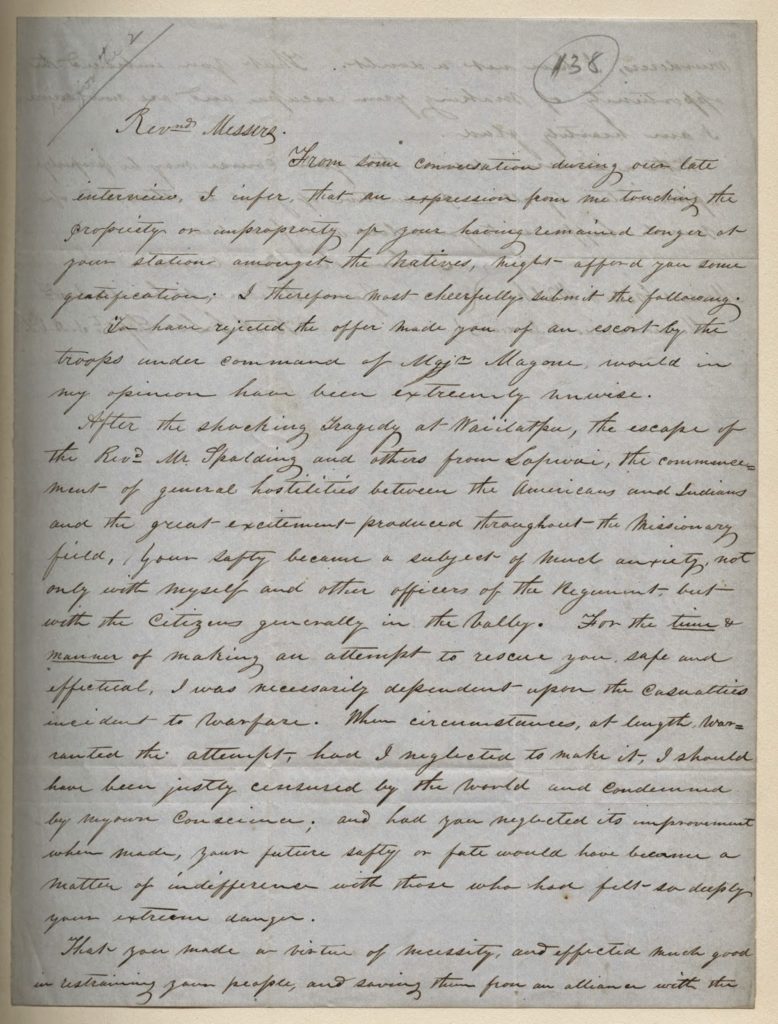Hello! I’m Callan, the Rosenbach’s newest Collections intern. I’m currently on a semester away from Whitman College in Walla Walla, a small town in the southeast corner of Washington State. I was therefore excited to investigate the Rosenbach’s collection of documents related to the early settlement of the Oregon Country, especially those pertaining to Washington State history. It didn’t take long for me to come across a pair of familiar names: Marcus and Narcissa Whitman, who were in fact the namesakes of my very own Whitman College.
The Rosenbach has a large collection of correspondence from missionaries in the Oregon Country, including letters written by, to, or about the Whitmans. The Whitmans were Methodists who traveled West from New York around 1836 and established a mission at the Cayuse settlement of Waiilatpu, which is located just outside of modern-day Walla Walla. There, Narcissa established a school for Native American children while Marcus provided medical care; they also took in orphaned settlers’ children and provided aid and shelter to those traveling through on the Oregon Trail.
However, the reason Marcus and Narcissa Whitman are famous names in Washington State history is due to their violent deaths in 1847—an event which is mentioned in several of the Rosenbach’s letters. An epidemic of measles struck the Waiilatpu area in the fall of that year, affecting both whites and Cayuse. Though Marcus attempted to treat all those who were ill, most whites survived while about half the Cayuse, including nearly all their children, died. In retribution, several Cayuse entered the mission on November 29, 1847 and killed fourteen whites, including Marcus, Narcissa, and several other male settlers and hired hands. The 50 or so remaining women and children were held as hostages for over a month until their release was negotiated.
The Whitman Massacre, as it is now known, sent shockwaves through the Oregon Country missionary community. Two letters in the Rosenbach’s collection refer to the event in the months after it occurred:
 |
| Henry A.G. Lee, autograph letter signed to Elkanah Walker and Cushing Eels. The Making of Oregon collection VI:138. The Rosenbach of the Free Library of Philadelphia |
of Indian Affairs of Oregon) writes to missionaries Elkanah Walker and Cushing
Eells to congratulate them on their behavior and safe evacuation in the
aftermath of the massacre:
shocking tragedy at Waiilatpu, the escape of the Rev. Mr. Spalding and others
from Lapwai, the general commencement of hostilities between the Americans and
Indians and the great excitement produced throughout the Missionary field, your
safety became a subject of much anxiety, not only with myself and other
officers of the Regiment, but with the citizens generally in the valley…That
you made a virtue of necessity, and effected much good in restraining yourself
and your people, and saving them from an alliance with the murderers, I have
not a doubt. That you embraced the opportunity of making your escape and are
now secure I am heartily glad.
Tshimakain mission, in Spokane territory, at the time of the massacre. They
were safely escorted to Oregon City by volunteer militia in June 1848, which
Lee refers to in the above letter.
 |
| William Craig, autograph letter signed to Elkanah Walker.10 April 1848 The Making of Oregon collection VI. The Rosenbach of the Free Library of Philadelphia |
Agent stationed at Lapwai, a mission in present-day Idaho) writes to Elkanah
Walker about the relations with the Indian tribes in the Waiilatpu area:
The letter of Eells came to hand yesterday
stating that the feeling of your Indians which was very happy to hear that they
was friendly disposed towards the whites. There is a few Cayuses pretends to be
friends of the whites, some disputes the reality of their friendship. The Walla
Walla chief also says he is friendly…The news came here on Saturday that the
Palus and Spokan [Spokane] Indians
had all joined the Murders [murderers]
and would be there in a few days. We are expecting a reinforcement every day
from the Dallas [Dalles].
This letter, written several months after the massacre,
demonstrates that the missionaries in the Waiilatpu and surrounding areas
seemed to be on improved terms with the local tribes. However, Craig warns
Walker to be cautious, especially since some tribes sided with the Cayuse who
perpetrated the massacre.
incident ultimately had a significant effect on relations between native tribes
and white settlers in the area and eventually led to a war between the Cayuse
and white militia. As for the Whitmans, their fellow missionary Cushing Eells
(the recipient of the first letter) founded the Whitman Seminary, later to
become Whitman College, in their memory in 1859. Though the Waiilatpu mission
buildings are now long gone, the location is now a National Historic Site with a
small museum just outside Walla Walla.
